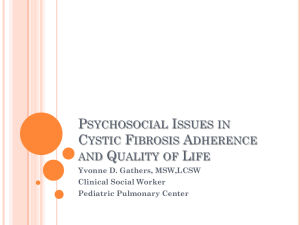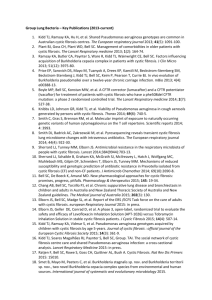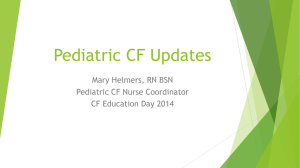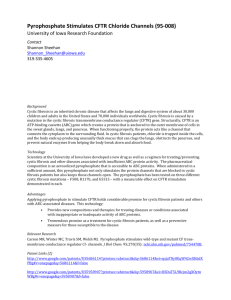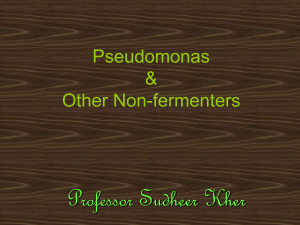Recent advances in the treatment of bacterial
advertisement
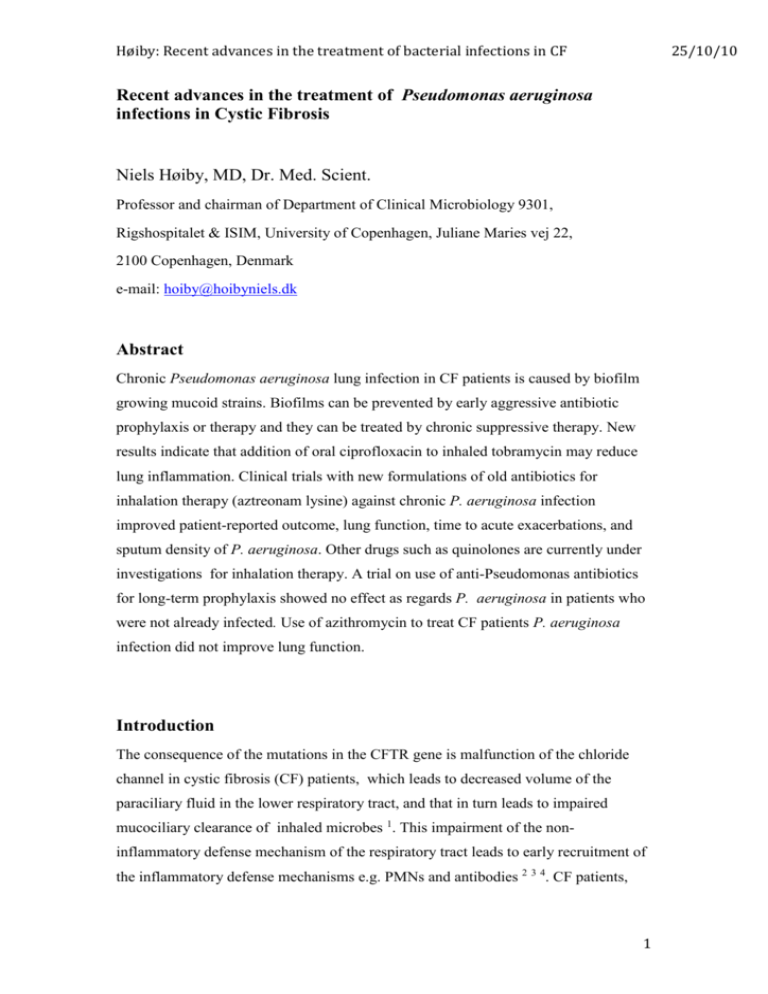
Høiby: Recent advances in the treatment of bacterial infections in CF 25/10/10 Recent advances in the treatment of Pseudomonas aeruginosa infections in Cystic Fibrosis Niels Høiby, MD, Dr. Med. Scient. Professor and chairman of Department of Clinical Microbiology 9301, Rigshospitalet & ISIM, University of Copenhagen, Juliane Maries vej 22, 2100 Copenhagen, Denmark e-mail: hoiby@hoibyniels.dk Abstract Chronic Pseudomonas aeruginosa lung infection in CF patients is caused by biofilm growing mucoid strains. Biofilms can be prevented by early aggressive antibiotic prophylaxis or therapy and they can be treated by chronic suppressive therapy. New results indicate that addition of oral ciprofloxacin to inhaled tobramycin may reduce lung inflammation. Clinical trials with new formulations of old antibiotics for inhalation therapy (aztreonam lysine) against chronic P. aeruginosa infection improved patient-reported outcome, lung function, time to acute exacerbations, and sputum density of P. aeruginosa. Other drugs such as quinolones are currently under investigations for inhalation therapy. A trial on use of anti-Pseudomonas antibiotics for long-term prophylaxis showed no effect as regards P. aeruginosa in patients who were not already infected. Use of azithromycin to treat CF patients P. aeruginosa infection did not improve lung function. Introduction The consequence of the mutations in the CFTR gene is malfunction of the chloride channel in cystic fibrosis (CF) patients, which leads to decreased volume of the paraciliary fluid in the lower respiratory tract, and that in turn leads to impaired mucociliary clearance of inhaled microbes 1. This impairment of the noninflammatory defense mechanism of the respiratory tract leads to early recruitment of the inflammatory defense mechanisms e.g. PMNs and antibodies 2 3 4. CF patients, 1 Høiby: Recent advances in the treatment of bacterial infections in CF 25/10/10 therefore, from early childhood suffer from recurrent and chronic respiratory tract infections characterized by PMN inflammation. In spite of the inflammatory response and intensive antibiotic therapy, however, infections caused by P. aeruginosa, the Burkholderia cepacia complex (mostly B. multivorans and B. cenocepacia) and Achromobacter xylosoxidans, persist and lead to respiratory failure and lung transplantation or death of the patients 5. Several other species including Staphylococcus. aureus, Haemophilus. influenzae, Stenotrophomonas. maltophilia and Mycobacteria other than tuberculosis and Aspergillus fumigatus also contribute to the mortality and morbidity 5. Adaptive mechanisms of P. aeruginosa exist which explain why this pathogen is able to survive and persist for several decades in the respiratory tract of CF patients in spite of the defense mechanisms of the host and intensive antibiotic therapy. P. aeruginosa is able to survive by switching to the biofilm mode of growth which provides tolerance to the inflammatory defense mechanism, to the aerobic respiratory zone and to the conductive zone of the lungs which contain anaerobic sputum, and to the antibiotic therapy 6 7 8. The biofilm strategy is also used by Burkholderia, Achromobacter and Stenotrophomonas 9. Current strategies for management of bacterial infections in cystic fibrosis The lungs consist of the smaller conductive zone and the larger respiratory zone. The respiratory zone includes respiratory bronchioles, alveolar ducts and alveolar sacs 10 11 . This part of the lungs has no cilia, no goblet cells and no submucosal glands and the defense system includes alveolar macrophages and defensins. All the venous blood of the body passes through the capillaries of the alveoles, which consist of a nearly continuous sheet of blood and only a very thin barrier is present between the air and the blood. The smaller conducting zone includes trachea, the bronchi and the terminal bronchioles. This part of the lungs has cilia, goblet cells and submucal glands and has a ordinary arterial blood supply from aorta. The mucus is produced in the respiratory zone and the major defense system is the muco-ciliary escalator 10 and PMNs recruitted from the respiratory zone 12. 2 Høiby: Recent advances in the treatment of bacterial infections in CF 25/10/10 Nebulised tobramycin and colistin and other antibiotics are widely used to treat P. aeruginosa lung infection in CF patients. Very high concentrations of these drugs are obtained in the conductive zone (sputum), whereas very little actually reaches the respiratory zone, since the measurable concentration in serum, which reflects the amount in the respiratory zone, is very low 13 14 15 16 17 . On the contrary, when antibiotics are administred intravenously or orally, very low concentrations are found in sputum, but high concentrations in the respiratory tissue because the whole dose of e.g. an intravenous bolus of antibiotics is transported directly by the blood to the alveolar capillaries before being distributed to the rest of the body 18. Since both the respiratory and the conductive zones of the lungs are infected with P. aeruginosa, there is both in vitro and in vivo pharmacokinetic/pharmacodynamic evidence for using combined systemic and nebulised antibiotics in CF patients 19 20 21. Most of the research in antibiotic management of bacterial infections in CF is carried out in intermittently colonized patients to prevent chronic infection or in chronically infected patients to prevent further tissue damage in the respiratory zone. These current therapeutic strategies are described in consensus reports 22 23. However, the burden of treatment for CF patients is large and adherence to therapy may therefore be difficult so there is a great need for novel therapeutic strategies Recent trials and results 1. Inhaled medications and inhalation devices The particle size (1-5µm), the lung dose delivered (3-8% - >50%) and the administration time (10-20 min to < 2-3 min.) have all improved during recent years as treatment of lung infections with antibiotics administred by inhalation therapy has become standard care in CF centers. This important development means that some antibiotics like colistin, tobramycin and aztreonam can now be inhaled within 2-3 minutes x1-3/day. The development from jet nebulizers to dry-powder inhalers and pressured metered dose inhalers and the relevant publications are summarized in two excellent recent surveys 24 25. 2. Inhaled versus systemic antibiotics for early eradication therapy 3 Høiby: Recent advances in the treatment of bacterial infections in CF 25/10/10 Inhaled tobramycin has been shown to transiently clear P. aeruginosa from lower airways in CF patients but does not markedly reduce lung inflammation, which is a key factor in disease progression 26. Clinical stable CF children (0.5 – 16 years) with recent P. aeruginosa infections were therefore randomized to receive 4 weeks of inhaled tobramycin or two weeks of systemic i.v. ceftazidime and tobramycin. If i.v. treatment was not possible, oral ciprofloxacin and nebulized tobramycin for 2 weeks was used alternatively. Bronchoalveolar lavage fluid (BALF) was obtained just before and 4-6 weeks after treatment. It was considered impossible to blind the study, but measurement of inflammatory parameters was done blindly. The primary outcome was change in % PMNs in BALF from the ’worst lobe’ and secondary parameters were change i total cells, PMNs, cytokines and bacterial quantity. Only 21 of 41 patients agreed to be enrolled and only 15 patients completed the study (6 in the inhaled group and 9 in the systemic group). The study was therefore underpowered which explains why most of the results were non-significant. However, median changes in total cells/ml and in PMNs/ml BALF were substantially greater in the systemic group than the inhaled group (p<0.01 and p<0.02), and the greatest decrease was found in the patients treated with both ciprofloxacin and tobramycin, whereas the inhaled group showed little change. A large multi-center study is therefore still needed, where oral ciprofloxacin combined with nebulized tobramycin or colistin is compared with nebulized tobramycin or colistin using the same primary and secondary parameters 26. 3. Nebulized Aztreonam Lysine for P. aeruginosa infection Three phase III studies have recently been published. Two were multinational, multicenter, randomized, double-blind, placebo-controlled studies, where a 28-day course of 75 mg aztreonam lysine given x3/day (AIR-CF1, 164 patients)27 or x2/day and x3/day (AIR-CF2, 211 patients)28 were compared with placebo as maintenance treatment for chronic P. aeruginosa infection in moderately-to-severe lung disease (25%≤FEV1≤75% predicted) where the patients in AIR-CF1 had no recent use of anti-pseudomonal antibiotics or azithromycin, wheras AIR-CF2 had just completed a 28 days course of tobramycin inhalation. The primary end-point in AIR CF-1 was patient-reported outcomes using the Cystic Fibrosis Questionaire-Revised Respiratory Scale (CFQ-R) and in AIR-CF2 the end-point was the time needed for inhaled or i.v. anti-pseudomonal antibacterials. Both trials are well performed and reached 4 Høiby: Recent advances in the treatment of bacterial infections in CF 25/10/10 conclusive results which can be used in daily treatment of CF patients. AIR-CF1 showed a significant improvement of CFQ-R scores, FEV1 and decrease of P. aeruginosa density in sputum compared with placebo and AIR-CF2 showed significant delayed time (21 days) needed for inhaled or systemic anti-pseudomonal antibiotics and AIR-CF2 showed the same improvement of CFQ-R scores, FEV1 and P. aeruginosa density as in AIR-CF1. Comparable results were obtained with the x2/day and x3/day dosing regimes. Adverse events were the same in the placebo arms and aztreonam arms and consistent with CF lung disease. A transient 4-fold increase of MICs were found in the aztreonam treated patients. Median sputum concentrations of aztreonam was 451-677 µg/g sputum and 0.5-0.6 µg/ml serum (AIR-CF1). The patients enrolled in AIR-CF1 and AIR-CF2 were then followed for 18 months in the open-labeled AIR-CF3 study (274 patients) where up to 9 repeated 28 days courses of x2/day (85 patients) and x3/day (189 patients) of aztreonam were given alternating with 28 days off treatment 29. The endpoint measures were CFQ-R score and a number of non-respiratory quality of life scores in addition to sputum P. aeruginosa density and % of days and number of days hospitalized, time to first respiratory hospitalization and % change in weight and the time to use i.v. antibiotics. Generally, the results from AIR-CF1 and AIR–CF2 studies were replicated in this study but the x3/day dosing was significant better than the x2/day dosing in terms of lung function and respiratory symptoms. Adherence to treatment was 92% in the x2/day and 88% in the x3/day groups 29. 4. Cycled antibiotic prophylaxis to prevent P. aeruginosa colonization. Early aggresive eradication of intermittent P. aeruginosa colonization is a treatment that has to be repeated to keep most of the patients free of chronic P. aeruginosa infection 30. A triple-blind placebo-controlled randomised 3-year study (65 CF children) was therefore carried out to investigate whether 3-monthly 3-week treatments with oral ciprofloxacin and inhaled colistin or both placebo would prevent initial P. aeruginosa infection 31. The primary outcome was P. aeruginosa infection and therefore respiratory cultures were obtained every 3 months. The percentage of cultures containing non-fermenting Gram-negative bacteria other than P. aeruginosa was significantly higher in the treatment group, which suggests thatthe three-monthly prophylaxis did not reduce the risk of initial and chronic P. aeruginosa infection. 5 Høiby: Recent advances in the treatment of bacterial infections in CF 25/10/10 5. Effect of azithromycin on pulmonary function in CF patients without P. aeruginosa infection Azithromycin is used routinely in the treatment of CF patients with chronic P. aeruginosa infection since a number of trials both in CF adults and children showed improvement in lung function 32. The mechanism by which azithromycin works is thought to be through inhibition of bacterial communication (quorum sensing) and reduction of inflammation since azithromycin does not inhibit growth of P. aeruginosa at the concentrations obtainable in vivo. This was the rationale behind a large (260 patients, 6-18 years) multi-center, randomized, double-blind, placebocontrolled trial where azithromycin (250 mg or 500 mg dependent on body weight was given every other day to patients who had negative P. aeruginosa cultures for at least one year. The primary outcome was change in FEV1 33. The outcome was, however, negative since 24 weeks treatment with azithromycin did not result in improved pulmonary function although the treated group had reduction in exacerbations and cough compared with the placebo group. On the other hand, significantly more macrolide resistant S. aureus and H. influenzae were isolated in the treated group. Ongoing studies At present, there are two multicenter, randomised, double-blind, placebo-controlled studies focus on prevention of chronic P. aeruginosa infection by early aggressive eradication. The American (300 patients, 1-12 years) multicenter EPIC study 34has 4 arms, where 28 days of 4 different treatment inhalation strategies are compared. Two culture-based therapies 1) Inhaled tobramycin and oral placebo, 2) inhaled tobramycin and 14 days oral ciprofloxacin, and the two cycled therapies 3) inhaled tobramycin and oral placebo, and 4) inhaled tobramycin and 14 days oral ciprofloxacin. 1) and 2) are repeated when quarterly respiratory cultures are found positive for P. aeruginosa and 3) and 4) are followed by 56 days off therapy, for six quarterly cycles. Preliminary results 35showed no significant differences between the 4 strategies neither with respect to P. aeruginosa positive cultures nor exacerbations and there was no concerns of drug toxicity or development of resistance. The Scandinavian (200 patients) multicenter study compare the standard 3-week nebulized colistin and oral ciprofloxacin and additional oral azithromycin or placebo for prevention of chronic P. aeruginosa infection36. This is a culture-based study and in addition screening of the patients for P. aeruginosa antibodies is used to assure, that the patients do have chronic infection at the enrollment. The rationale of the study is the demonstrated quorum sensing inhitory effect of azithromycin which could 6 Høiby: Recent advances in the treatment of bacterial infections in CF 25/10/10 disarm P. aeruginosa and thereby facilitate its early eradication6. The study is ongoing and no results have been reported. Hurdles for the future The major hurdle is the biofilm mode of growth of P. aeruginosa and also Burkholderia cepacia complex, Achromobacter xylosoxidans and Stenotrophomonas maltophilia which have become established CF pathogens resistant to eradication with antibiotics5 9. There are several possiblilities which should be tested in the future including inhibition of quorum sensing by e.g. garlic37, or break of the biofilm matrix by alginate lyase, F-actin or DNase 38. Conclusions Focusing new formulations of old antibiotics (aztreonam) on chronic P. aeruginosa infetion has been shown to be effective and a valuable addition to the current strategy of maintenance treatment of CF patients. Several other drugs such as quinolones are currently under investigations for inhalation therapy. On the other hand using antibiotics for long-term prophylaxis does not seem to be valuable as regards P. aeruginosa and the main indication for azithromycin treatment is still chronic P. aeruginosa lung infection. List of abbreviations CF: Cystic fibrosis CFTR: cystic fibrosis transmembrane conductance regulator PMN: Polymorphonuclear leukocytes i.v.: Intra-venous BALF: Bronchoalveolar lavage fluid FEV1: Forced expiratory volume in one second CFQ-R: Cystic Fibrosis Questionaire-Revised Respiratory Scale DNase: Desoxy-ribonuclease Competing interests None 7 Høiby: Recent advances in the treatment of bacterial infections in CF 25/10/10 References 1. Boucher RC. New concepts of the pathogenesis of cystic fibrosis lung disease. Eur Resp J 2004;23(1):146-58. 2. Høiby N, Johansen HK, Moser C, Song ZJ, Ciofu O, Kharazmi A. Pseudomonas aeruginosa and the biofilm mode of growth. Microbes and Infection 2001;3:1-13. 3. Armstrong DS, Grimwood K, Carzino R, Carlin JB, Olinsky A, Phelan PD. Lower respiratory infection and inflammation in infants with newly diagnosed cystic fibrosis. Br Med J 1995;310(6994):1571-72. 4. Armstrong DS, Hook SM, Jamsen KM, Nixon GM, Carzino R, Carlin JB, et al. Lower airway inflammation in infants with cystic fibrosis detected by newborn screening. Ped. Pulmonol. 2005;40:500-10. 5. Høiby N, Pressler T. Emerging patogens in cystic fibrosis. . In: Webb AK, Ratjen F, editors. European Respiratory Monograph in Cystic Fibrosis.: European Respiratory Society, 2006:66-78. 6. Hoffmann N, Rasmussen TB, Jensen PØ, Stub C, Hentzer M, Molin S, et al. Novel mouse model of chronic Pseudomonas aeruginosa lung infection mimicking cystic fibrosis. Infection and Immunity 2005;73:2504-14. 7. Jelsbak L, Johansen HK, Frost A-L, Thøgersen R, Thomsen LE, Ciofu O, et al. Molecular epidemiology and dynamics of Pseudomonas aeruginosa populations in lungs of cystic fibrosis patients. . Infection and Immunity 2007;75:2214-24. 8. Bjarnsholt T, Jensen PØ, Fiandaca MJ, Pedersen J, Hansen CR, Andersen CB, et al. Pseudomonas aeruginosa biofilms in the respiratory tract of cystic fibrosis patients. Pediatric Pulmonology 2009;44:547-58. 9. Hansen CR, Pressler T, Nielsen KG, Jensen PØ, Bjarnsholt T, Høiby N. Inflammation in Achromobacter xylosoxidans infected cystic fibrosis patients. Journal of Cystic Fibrosis 2010;9:51-58. 10. Westh JB. Pulmonary physiology and pathophysiology. Philadelphia: Lippincott Williams & Wilkins, 2001. 11. Høiby N. P. aeruginosa in cystic fibrosis patients resists host defenses, antibiotics. . Microbe (ASM) 2006;1(12):571-77. 12. Kolpen M, Hansen CR, Bjarnsholt T, Moser C, Christensen LD, van Gennip M, et al. Polymorphonuclear leukocytes consume ooxygen in sputum from chronic Pseudomonas aeruginosa pneumonia in cystic fibrosis. Thorax 2010;65:57-62. 13. Levy J, Smith, A.L., Koup, J.R., Williams-Warren, J., & Ramsey, B. Disposition of tobramycin in patients with cystic fibrosis: A prospective controlled study. J. Pediat. 1984;105:117-24. 14. Ramsey BW, Pepe MS, Quan JM, Otto KL, Montgomery AB, WilliamsWarren J, et al. Intermittent administration of inhaled tobramycin in patients with cystic fibrosis. N Engl J Med 1999;340(1):23-30. 15. Gibson RL, Emerson J, McNamara S, Burns LL, Rosenfeld M, Yunker A, et al. Significant microbiological effect of inhaled tobramycin in young children with cystic fibrosis. Amer J Respir Crit Care Med 2003;167(6):841-49. 8 Høiby: Recent advances in the treatment of bacterial infections in CF 25/10/10 16. Geller DE, Pitlick WH, Nardella PA, Tracewell WG, Ramsey BW. Pharmacokinetics and bioavailability of aerosolized tobramycin in cystic fibrosis. Chest 2002;122(1):219-26. 17. Ratjen F, Rietschel E, Kasel D, Schwiertz R, Starke K, Beier H, et al. Pharmacokinetics of inhaled colistin in patients with cystic fibrosis. Journal of Antimicrobial Chemotherapy 2006;57:306-11. 18. Permin H, Koch C, Høiby N, Christensen HO, Møller AF, Møller S. Ceftazidime treatment of chronic Pseudomonas aeruginosa respiratory tract infection in cystic fibrosis. J Antimicrob Chemother 1983;12, supplementum A:31323. 19. Pamp SJ, Gjermansen M, Johansen HK, Tolker-Nielsen T. Tolerance to the antimicrobial peptide colistin in Pseudomonas aeruginosa biofilms is linked to metabolically active cells, and depends on the prm and mexABoprM genes. Molecular Microbiology 2008;68:223-40. 20. Jensen T, Pedersen SS, Garne S, Heilmann C, Høiby N, Koch C. Colistin inhalation therapy in cystic fibrosis patients with chronic Pseudomonas aeruginosa lung infection. J. Antimicrob. Chemother. 1987;19:831-38. 21. Valerius NH, Koch C, Hoiby N. Prevention of Chronic PseudomonasAeruginosa Colonisation in Cystic Fibrosis by Early Treatment. Lancet 1991;338(8769):725-26. 22. Döring G, Conway SP, Heijerman HGM, Hodson ME, Høiby N, Smyth A, et al. Antibiotic therapy against Pseudomonas aeruginosa in cystic fibrosis: a European consensus. Eur Resp J 2000;16(4):749-67. 23. Döring G, Høiby N. Early intervention and prevention of lung disease in cystic fibrosis: a European consensus. Journal of Cystic Fibrosis 2004;3:67-91. 24. Heijerman H, Westerman E, Conway S, Touw D, Döring G, Group TCW. Inhaled medication and inhalation devices for lung diseases in patients with cystic fibrosis: A European consensus. . Jouernal of Cystic Fibrosis 2009;8:295-315. 25. Geller DE. Aerosol antibiotics in cysic fibrosis. Respiratory Care 2009;54:65869. 26. Noah TL, Ivins SS, Abode KA, Stewart PW, Michelson PH, Harris WT, et al. Inhaled versus systemic antibiotics and airway inflammation in children with cystic fibrosis and Pseudomonas. Pediatric Pulmonology 2010;45:281-90. 27. Retsch-Bogart GZ, Quittner AL, Gibson RL, Oermann CM, McCoy KS, Montgomery AB, et al. Efficacy and safety of inhaled aztreonam lysine for airway Pseudomonas in cystic fibrosis. Chest 2009;135:1223-32. 28. McCoy KS, Quittner AL, Oermann CM, Gibson RL, Retsch-Bogart GZ, Montgomery AB. Inhaled aztreonam lysine for chronic airway Pseudomonas aeruginosa in cystic fibfosis. Am. J. Respir. Crit. Care Med. 2008;178:921-28. 29. Oermann CM, Retsch-Bogart GZ, Quitner AL, Gibson. R.L., McCoy KS, Montgomery AB, et al. An 18-month study of the safety and efficacy of repeated courses of inhaled aztreonam lysine in cystic fibrosis. Pediatric Pulmonology 2010;45:1-14. 30. Hansen CR, Pressler T, Høiby N, . Early aggressive eradication therapy for intermittent Pseudomonas aeruginosa airway colonization in cystic 9 Høiby: Recent advances in the treatment of bacterial infections in CF 25/10/10 fibrosis patients: 15 years experience. Journal of Cystic Fibrosis 2008;7:523-30. 31. Tramper-Stranders GA, Wolfs TFW, van Haren Noman S, van Aalderen WMC, Nagelkerke AF, Nuijsink M, et al. Controlled trial of cycled antibiotic prophylaxis to prevent initial Pseudomonas aeruginosa infection in children with cystic fibrosis. Thorax 2010;65:915-20. 32. Yousef AA, Jaffe A. The role of azithromycin in patients with cystic fibrosis. Paediatric Respiratory Reviews 2010;11:108-14. 33. Saiman L, Anstead M, Mayer-hamblett N, Lnads LC, Kloster M, Hocevar-Trnka J, et al. Effect of azithromycin on pulmonary fundtion in patients with cystic fibrosis uninfected with Pseudomonas aeruginosa. A randomized controlled trial. JAMA 2010;303:1707-15. 34. Treggiari M, Rosenfeld M, Mayer-Hamblett N, Retsch-Bogart G, Gibson RL, Williams J, et al. Early anti-pseudomonal acquisition in yung patients with cystic fibrosis: Rationale and design of the EPIC clinical trial and observational study. Contemporary Clinical Trials 2009;30:256-68. 35. Treggiari M, Retsch-Bogart G, mayer-Hamblett N, Khan U, Kronmal R, Ramsey B, Ren, C.L.,, et al. Comparative efficacy and safety of four randomized regimens tp treat early Pseudomonas aeruginosa infection in children with cystic fibrosis.(Abstract). Journal of Cystic Fibrosis 2010;9(Supplementum 1):54. 36. Høiby N, Hansen CR, group SCFS. Prevention of chronic P. aeruginosa infection by antibiotic treatment of intermittent colonization in patients with cystic fibrosis. Nebulized colistin + oral ciprofloxacin and azithromycin compared with colistin + oral ciprofloxacin. Copenhagen: Danish Cystic Fibrosis Center, Rigshospitalet, Denmark, 2009. 37. Smyth AR, Cifelli PM, Ortori CA, TTighetti K, Lewis S, Erskine P, et al. Garlic as an inhibitor of Pseudomonas aeruginosa qquorum sensing in cystic fibrosis - a pilot randomized controlled trial. Pediatric Pulmonology 2010;45:356-62. 38. Tolker-Nielsen T, Høiby N. Extracellular DNA and F-actin as targets in antibiofilm CF therapy. Future Microbiology 2009;4:645-47. 10

